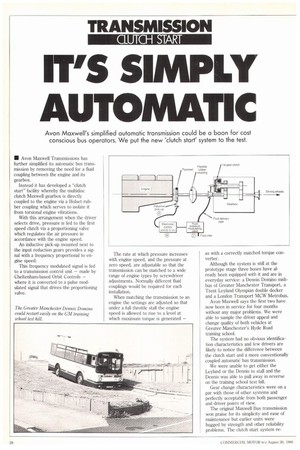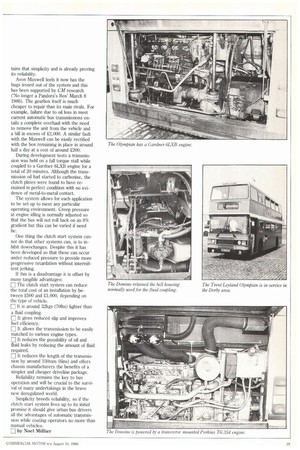IT'S SIMPLY AUTOMATIC
Page 30

Page 31

If you've noticed an error in this article please click here to report it so we can fix it.
Avon Maxwell's simplified automatic transmission could be a boon for cost conscious bus operators. We put the new 'clutch start' system to the test.
• Avon Maxwell Transmissions has further simplified its automatic bus transmission by removing the need for a fluid coupling between the engine and its gearbox.
Instead it has developed a "clutch start" facility whereby the multidisc clutch Maxwell gearbox is directly coupled to the engine via a Holset rubber coupling which serves to isolate it from torsional engine vibrations.
With this arrangement when the driver selects drive, pressure is fed to the first speed clutch via a proportioning valve which regulates the air pressure in accordance with the engine speed.
An inductive pick-up mounted next to the input reduction gears provides a signal with a frequency proportional to engine speed.
This frequency modulated signal is fed to a transmission control unit — made by Cheltenham-based Orbit Controls — where it is converted to a pulse modulated signal that drives the proportioning valve. The rate at which pressure increases with engine speed, and the pressure at zero speed, are adjustable so that the transmission can be matched to a wide range of engine types by screwdriver adjustments. Normally different fluid couplings would be required for each installation.
When matching the transmission to an engine the settings are adjusted so that under a full throttle stall the engine speed is allowed to rise to a level at which maximum torque is generated — as with a correctly matched torque converter.
Although the system is still at the prototype stage three buses have already been equipped with it and are in everyday service: a Dennis Domino midibus of Greater Manchester Transport, a Trent Leyland Olympian double decker and a London Transport MCW Metrobus.
Avon Maxwell says the first two have now been in service for four months without any major problems. We were able to sample the driver appeal and change quality of both vehicles at Greater Manchester's Hyde Road training school.
The system had no obvious identification characteristics and few drivers are likely to notice the difference between the clutch start and a more conventionally coupled automatic bus transmission.
We were unable to get either the Leyland or the Dennis to stall and the Dennis was able to pull away in reverse on the training school test hill.
Gear change characteristics were on a par with those of other systems and perfectly acceptable from both passenger and driver points of view.
The original Maxwell Bus transmission won praise for its simplicity and ease of maintenance but earlier units were bugged by strength and other reliability problems. The clutch start system re tains that simplicity and is already proving its reliability.
Avon Maxwell feels it now has the bugs ironed out of the system and this has been supported by CM research (No longer a Pandora's Box' March 8 1986). The gearbox itself is much cheaper to repair than its main rivals. For example, failure due to oil loss in most current automatic bus transmissions entails a complete overhaul with the need to remove the unit from the vehicle and a bill in excess of £2,000. A similar fault with the Maxwell can be easily rectified with the box remaining in place in around half a day at a cost of around 2200.
During development tests a transmission was held on a full torque stall while coupled to a Gardner 6LXI3 engine for a total of 20 minutes. Although the transmission oil had started to carbonise, the clutch plates were found to have remained in perfect condition with no evidence of metal-to-metal contact.
The system allows for each application to be set up to meet any particular operating environment. Creep pressure at engine idling is normally adjusted so that the bus will not roll back on an 8% gradient but this can be varied if need be.
One thing the clutch start system cannot do that other systems can, is to inhibit downchanges. Despite this it has been developed so that these can occur under reduced pressure to provide more progressive retardation without intermittent jerking.
If this is a disadvantage it is offset by many tangible advantages: The clutch start system can reduce the total cost of an installation by between .500 and £1,000, depending on the type of vehicle.
fl It is around 32kgs (70Ibs) lighter than a fluid coupling. E It gives reduced slip and improves fuel efficiency. E It allows the transmission to be easily matched to various engine types. 0 It reduces the possibility of oil and fluid leaks by reducing the amount of fluid required.
It reduces the length of the transmission by around 150mm (6ins) and offers chassis manufacturers the benefits of a simpler and cheaper driveline package.
Reliability remains the key to bus operation and will be crucial to the survival of many undertakings in the brave new deregulated world.
Simplicity breeds reliability, so if the clutch start system lives up to its initial promise it should give urban bus drivers all the advantages of automatic transmission while costing operators no more than manual vehicles.
1=I by Noel Millier












































































